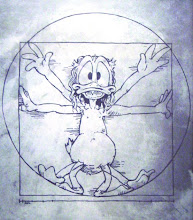 Please remember that Schrodinger intended for his poor little cat's impending doom to be a shocking if not mechanically quantified example of the crazy things that happen when physics leaps from reality to imagination. That is, when physics stops dealing with the practically visible world such as planets and oranges and monkeys, and starts dealing with the invisible and theoretically imagined world of quarks, higgs bosons and dark matter.
Please remember that Schrodinger intended for his poor little cat's impending doom to be a shocking if not mechanically quantified example of the crazy things that happen when physics leaps from reality to imagination. That is, when physics stops dealing with the practically visible world such as planets and oranges and monkeys, and starts dealing with the invisible and theoretically imagined world of quarks, higgs bosons and dark matter.In order to illustrate the problem with Einstein's 'matter both is and is not in all possible states at the same time' claim, Shrodinger did what Charles DeKoninck--and any other natural philosopher worth his weight in negative matter would have done-- move from the more known to the less known. What it means for quantum particles to be in all states at the same time is not very knowable, mainly because it's so impractically visible. But, when the same argument is transferred to the more known, i.e. the kind of thing that we humans can relate to on the natural level such as when a cat is both alive and dead at the same time, it becomes immediately apparent that the line of reasoning that got us there is, well, faulty.
The sad thing is that is that many people now use the Shrodinger's cat example in quite the opposite way: rather than saying "Oh, poo. My conclusion is obviously false, therefore my argument must be faulty somewhere along the line, quite possibly at the beginning with poor assumed principles. I shall start over with better principles and more rigorous syllogisms", they actually say: "Huh, would you look at that. The conclusion might seem false but I just can't admit it, therefore it must be true. Therefore your system of logic that says it's false must instead be faulty. Let me devise a new system of logic that allows for the violation of the law of non-contradiction so that I do not need to re-evaluate my world view at greater cost to my belief system that I happen to call science".
Schrodinger is and is not rolling over in his grave.



No comments:
Post a Comment